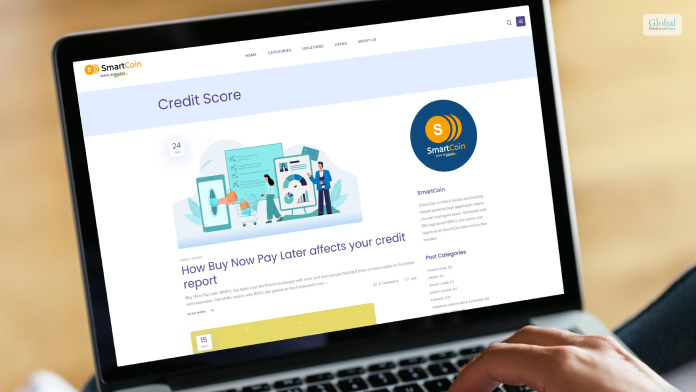SmartCoin: Information, Eligibility Criteria, Interest Rates, Review & More

Smart Coin brings the easiest opportunity for people with low levels of income to afford short-term personal loans. Whether you are self-employed or a salaried worker, you can take short-term personal loans from this app-based loan service that works with RBI-registered NBFCs.
However, what are the eligibility criteria for getting a smart coin loan? Is it safe? What do other customers who have taken loans from them have to say about Smart Coin?
Calm down, I know you have all of these questions. But, once you give this article a read, you will learn about all that you need to know. So, without any delay, let us start.
What Is A Smart Coin?

No, it is no cryptocurrency; the name might make you think of it as a cryptocurrency, but in reality, it is an app-based consumer lending platform. The platform partners with RBI-registered NBFCs to offer short-term loans to salaries, individuals, and freelancers.
Their vision is to address different concerns in the consumer loan sector in India. Although it started as a small lending corporation, its vision of micro-lending is evolving towards a larger dream. Their full suite offering will include gold savings, insurance, and more. They have more than 1 crore customers across India and more than 1700 CR disbursed in loan amount.
SmartCoig gives you small amounts of loans for a short-term tenure. You can take loans of 1000 rupees to 70000 rupees that last for a tenure between 91 days to 270 days. But the loans come with a minimum interest rate of 20% and a maximum interest rate of 36%.
Also, the platform is based on a patented algorithm, which helps the customers to do risk assessments before availing of their loans. The seamless online application of the Smartcoing app makes it easier for borrowers to get a loan. Once their application is deemed eligible, the money will be transferred to their account instantly.
Read More: How To Get Personal Loan On Bajaj Markets?
What Are The Offerings Of Smart Coin?
So what does the SmartCoin platform offer to its borrowers? Here are the different offerings of the smart coin lending software –
Instant Personal Loan

Now, you can get a loan within an instant. With smart coins, customers can get instant personal loans in their smartphones within a few minutes. Yes, the process is digital, but your security is not compromised. It is completely safe. All you need is for your application to get approved.
Gold Rewards

Not only loans but you can also be rewarded based upon how good of a borrower you are. Once you repay your loans timely and refer the platform to your friends for similar use, you will get gold rewards. Is not that amazing?
Gold Savings

The platform also offers 99.95 pure digital gold helping you to save and grow your saving. You can save a minimum of 10 rupees on 24K with the gold savings offerings of SmartCoin. It is undoubtedly one of the best opportunities for those looking for a reward savings option within a lending platform.
Credit Score

Your credit score can put a good impression on your financial graph. That is why you need to have a good credit score. Smartcoin lets you check your credit score from the Credit Score Bureau for free. This is what you need to stay disciplined financially.
Why Should Take Smart Coin Loans?

My point exactly. You can take loans from other lenders or lending partners. But why smart coin? Go through the points to know the benefits of taking loans from SmartCoin –
- This a collateral-free loan-providing platform: In other words, you don’t have to provide any collateral when applying for loans in Smart Coin. So, if you are thinking of borrowing some money, you don’t have to arrange money to pay collateral when applying for loans.
- Repeat loan is easier with Smart Coin: If you have repaid your loan and want to avail of another loan from smart coin, they don’t need you to submit the documents again. Once you have submitted your documents, it stays with them, and you can apply for a repeated loan without resubmission of your documents.
- The easy application process for borrowers: most banks and loan providers make the application process way too hectic. Going through all that difficult process only to get your application rejected is exhausting. But, with smart coins, the process is quite simple. They require only some minimal documents for the application.
- Direct Fund transmission: The application needs only a few minutes to be approved. Once approved, the fund gets transferred to the borrower’s account directly. As a result, you don’t have to wait around for days or weeks to get your loan approved and transmitted during a crisis.
Who Is Eligible To Use Smart Coin App?

If you want to avail of a loan from Smart Coin, you need to fulfill the below-mentioned eligibility criteria –
- Applicants need to be at least 23 years old to apply for a loan.
- The loans are only available to Indian residents.
- People who can apply for a loan are usually salaried individuals, business owners, and support executives.
- Applicants should have a minimum monthly income of 15000.
Documents You Need To Apply For Smart Coin Loans

You need the below-mentioned documents to apply for a loan at the Smart Coin platform –
- Bank statement
- Selfie of applicant
- Address Proof
- PAN card
How To Use Smart Coin App?

So, how to use the Smart Coin App? Here are the simple steps that you need to follow for that –
- First, go to your App Store or Google Play Store to download the app on your smartphone.
- Users can log in to the app using their Facebook or Google accounts.
- Now, they have to fill in the application for the loan.
- Now, they must upload the documents required for the approval of the loan.
- Once the application is approved, users will get the fund transmitted directly to their bank account.
You should follow these steps to get your loan funded in your bank. However, if you need more help, you can contact us through smartcoin customer care number ( Toll Free: 91483 80504).
Read More: StashFin Personal Loan Review – Interest Rates, Loan Amount, Eligibility, And More
Bottom Line
So, that was all the important info you needed to know on Smart Coin. This article can help you install, use and apply for loans on Smart coin. You can use the how-to-use section for smartcoin login also.
Hopefully, this article was helpful. However, if you have more queries, please let me know in the comment section. I will get back to you ASAP.
Read Also:













